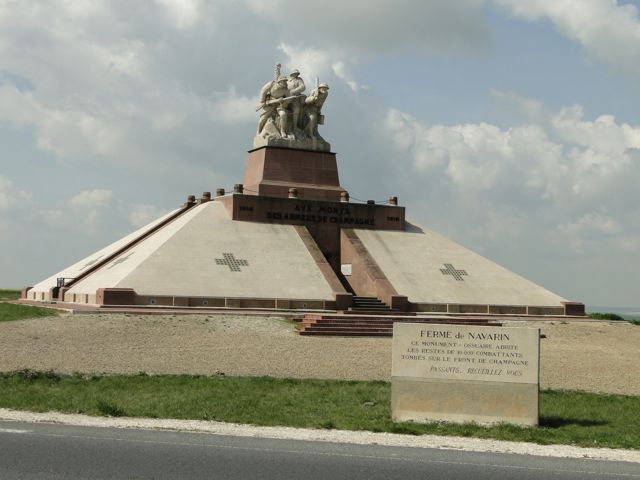93
Sign in front of monument : English translation - Navarin Farm, This ossuary monument houses the remains of 10.000 fallen veterans of Champagne. Pass by and reflect.
Sign 2: The Monument to the dead of the Armies of Champagne, and the Ossuary of Navarin
The Ossuary Monument, near the old farm of Navarin, which saw the worst of the combat, and of which no trace now remains, was erected thanks to funds raised by General Gouraud through public subscription. The laying of the foundation stone, which came from the ruins of the church of Souain, took place in 1923 in the presence of the Ambassador of the United States Myron Herrick. It was inaugurated by Marechal Joffre on 28th September 1924.
The size and proportions of the monument are impressive. The group of statues, which crown its summit, is the work of Real de Sarte. It represents three combatants in the course of an attack. The sculptor has given the soldier on the right the features of Quentin Roosevelt, the son of the President of the United States, who died in the service of France, and to the soldier on the left he has given the features of his brother, who was killed on the Chemin des Dames. To the grenadier in the centre, he has given the features of General Gouraud.
The main entrance leads to a chapel, on whose walls are a number of marble plaques carrying the names of soldiers who disappeared, placed there at the request of their families. The crypt contains ossuaries containing the unnamed remains of 10,000 soldiers, together with the tomb of General Gouraud, who wished to be buried in the midst of those whom he had commanded from 1916 to 1918 as head of the 4th Army.
A foundation, which is publicly recognised, provides for the upkeep of the building, and the "Association for the Memory of the Armies of Champagne" organises and imposing ceremony each year in the presence of senior civil and military figures from France and America. An open-air mass is celebrated as part of the ceremony.
Sign 3: The Memory
From the beginning of the conflict, soldiers have given tribute to their friends who died in a battle. Many monuments have been erected thanks to the contributions of those who survived and acquaintances of the deceased.
Each state is eager to remember the sacrifice and victory of its soldiers by building memorials, as those in Mondement or in Dormans.
The days following the Armistice, the temporary cemeteries were made in big necropolis and many monuments disappeared through the time. In 1920, the free towns of France were endowed with a war monument: thus engraving in stone the names of their sacrificed children.
The Navarin Monument
In the days following the war, the veterans decide to erect a monument to pay tribute to the deceased of the 107 French and allied divisions who fought on the front of Champagne department. Donations flowed from all over France and on November 4th 1923 the first stone is laid. Less than a year later on September 28th 1924 the unveiling of the Navarin monument took place in the term of office of Field Marshal Joffre and General Gouraud.
The monument has the shape of a pyramid on which there is a sculpture representing three soldiers in an attack position (right to left):
- Quentin Roosevelt, flying officer, son of former American President.
- The general Gouraud at the head of the IVth army
- The sculptor's brother who died at the Moulin of Laffaux
On the pink stoneware pedestal the numbers of the French and allied divisions having fought in Champagne are listed.
Inside, there is a chapel which walls are covered with plates placed by the families in memory of the dead soldiers.
While the necropolis were finished, many bones were still being exhumed from the battlefields, the Navarin monument was then changed into an ossuary. Today it is the shelter of more than 10,000 unidentified corpses of soldiers.
Since 1947, according to their own wishes, the corpses of the Generals Gouraud and Pretelat lain among their soldiers.






